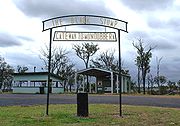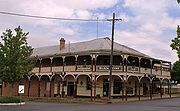
Black Stump
Encyclopedia

Australia
Australia , officially the Commonwealth of Australia, is a country in the Southern Hemisphere comprising the mainland of the Australian continent, the island of Tasmania, and numerous smaller islands in the Indian and Pacific Oceans. It is the world's sixth-largest country by total area...
n expression 'black stump' is the name for an imaginary point beyond which the country is considered remote or uncivilised, an abstract marker of the limits of established settlement. The origin of the expression, especially in its evolved use as an imaginary marker in the landscape, is contested. The various claims are discussed below.
One theory states that the expression derives from the use of black stumps in the landscape as markers when directing travellers. Other explanations relate to historical events associated with places or geographical features with names incorporating the phrase “black stump”. At least three regional Australian towns claim the expression originated in their general vicinity.
Vernacular formulations
The term ‘black stump’ is used in various formulations. The most common are:- • ‘beyond the black stump’ or ‘back of the black stump’ – in the outback; remote from civilisation. The following quote from John Wynnum’s I’m a Jack, all Right (1967; p. 18) conveys this meaning: “It’s way back o’ Bourke. Beyond the Black Stump. Not shown on the petrol station maps, even.”
- • ‘this side of the black stump’ – in the world known to the speaker; anywhere in the general community. The following is from Vision Splendid by Tom Ronan (1954; p. 264): “You’re looking... at the best bloody station bookkeeper this side of the black stump.”
Another use of the phrase ‘black stump’ in the Australian vernacular, which relates more to the real object than an abstract concept of landscape, is the local term for the old State Office Block in Sydney (now demolished). The high-rise building was dark-grey in colour and Sydney residents – “with the local talent for belittling anything that embarrassed them with its pretensions” – dubbed it ‘the Black Stump’.
Origin of the expression
The most prosaic explanation for the origin of ‘black stump’ derives from the general use of fire-blackened tree-stumps as markers when giving directions to travellers unfamiliar with the terrain. An early use of the phrase from the Sydney journal Bulletin (31 March 1900, p. 31) seems to lend support to this explanation: “A rigmarole of details concerning the turns and hollows, the big tree, the dog-leg fence, and the black stump”.Robbery Under Arms
Robbery Under Arms
Robbery Under Arms is a classic Australian novel by Rolf Boldrewood . It was first published in serialised form by The Sydney Mail between July 1882 and August 1883, then in three volumes in London in 1888...
, a fictionalised work by Rolf Boldrewood first published in 1888, refers to the Black Stump as an actual place "within a reasonable distance of Bathurst" and known to everybody for miles around. Boldrewood says it "had been a tremendous old Ironbark tree- nobody knew how old, but it had had its top blown off in a thunderstorm, and the carriers had lighted so many fires against the roots of it that it had been killed at last, and the sides were as black as a steamer's funnel."
Raffaello Carboni
Raffaello Carboni
Raffaello Carboni was an Italian revolutionary and writer. He is primarily remembered now as the author of the main eyewitness account of events at the Eureka Stockade in Ballarat, Australia.-Biography:...
used the phrase 'black-stump' in his account of the Eureka Stockade
Eureka Stockade
The Eureka Rebellion of 1854 was an organised rebellion by gold miners which occurred at Eureka Lead in Ballarat, Victoria, Australia. The Battle of Eureka Stockade was fought on 3 December 1854 and named for the stockade structure erected by miners during the conflict...
uprising which he wrote in 1855, probably referring to a well-worn pipe: "Please, give me a dozen puffs at my black-stump, and then I will proceed to the next chapter". There appears to be no obvious link between the use of the phrase by Carboni and the expression being used as an imaginary marker in the landscape.
Contested origin: places
The evolution of meaning of the phrase 'black stump', from the real to an imaginary marker of landscape, probably occurred during the nineteenth century. There is a widespread belief that the expression took root amongst carriers or teamstersBullocky
A bullocky is an Australian English term for the driver of a bullock team. Bullock drivers were also known as teamsters or carriers. The American term for a bullocky is a bullwhacker.-History:...
that operated in the regional districts of Australia. Carriers were an integral part of the rural economy during the nineteenth century; they transported wool and supplies by drays drawn by horse- or bullock-teams, travelling constantly across the landscape servicing stations and settlements distant from regional transport hubs and urban centres.
If the use of the expression ‘black stump’ entered the Australian vernacular in the nineteenth century, it rarely appeared in Australian literature or newspaper reports until the twentieth century.
At least three towns in regional Australia claim to be home to the 'black stump': Coolah, NSW; Merriwagga and Gunbar in NSW; and Blackall in Queensland.
Coolah, NSW

Coolah, New South Wales
Coolah is a town in the central northern part of New South Wales, Australia in Warrumbungle Shire. At the 2006 census, Coolah had a population of 798....
was known by local Aborigines as ‘Weetalibah-Wallangan’, apparently meaning “place were the fire went out and left a burnt stump”. In an attempt to control the settlement patterns of the colony of New South Wales Governor Darling
Ralph Darling
General Sir Ralph Darling, GCH was a British colonial Governor and Governor of New South Wales from 1825 to 1831.-Early career:...
issued regulations in 1829 limiting settlement in the colony to land within the Nineteen Counties surrounding Sydney. The regulations defined the “limits of location”, and it is claimed this boundary passed “along the approximate location of the Black Stump Run” (located just north-west of present-day Coolah). Land to the north of this part of Governor Darling’s boundary (it is asserted) began to be described as "beyond the Black Stump".
This raises the question: had the Black Stump Run been taken up by 1829 (or at least by the mid-1830s)? Darling’s “limits of location” was a short-lived concept; in 1836 Governor Bourke
Richard Bourke
General Sir Richard Bourke, KCB was Governor of the Colony of New South Wales, Australia between 1831 and 1837.-Early life and career:...
allowed individuals occupying lands beyond the Nineteen Counties to obtain annual licenses to legitimise their activities and the “limits of location” became officially irrelevant.
Apparently a teamster named John Higgins took up land in the vicinity of the Black Stump Run (possibly in the early 1860s when Robertson's Land Bills allowed land selection to occur). Higgins built an inn in the 1860s which he called The Black Stump Inn, located at the junction of roads leading to Gunnedah and Coonabarabran. The inn later became the Black Stump Wine Saloon and was destroyed by fire in 1908. It has been suggested that the saloon was an important staging post for traffic to north-west New South Wales and it became a marker by which people gauged their journeys.
Coolah’s claim to the term ‘black stump’ would be considerably strengthened if a reference to the expression were found in literature or newspaper reports from the nineteenth century (particularly prior to the mid-1880s).
Merriwagga / Gunbar (NSW)
The village of MerriwaggaMerriwagga, New South Wales
Merriwagga is a rural village community in the northern part of the Riverina. It is situated by road, about 20 kilometres north west from Goolgowi and 42 kilometres south from Hillston on the Kidman Way in NSW. According to the ABS Census 2001 it has a population of 66 people...
and nearby community of Gunbar
Gunbar, New South Wales
Gunbar is in the Riverina district of south-western New South Wales in Australia, on a wide bend of the Mid-Western Highway between Goolgowi and Hay. It is part of the Carrathool Shire local government area, administered from Goolgowi...
, in the Riverina district of New South Wales, have strong claims to the origin of the expression ‘black stump’. Gunbar cemetery is the burial-place of Mrs. Barbara Blain, the woman whose accidental death in March 1886 possibly gave rise to the term.
Barbara Blain’s husband, James, was a carrier or teamster, based at Hay. In March 1886 James and Barbara Blain, in company with other carriers, stopped to camp at a pine ridge on “Gunbar” station. James and the other men left to load posts onto their drays and Barbara began preparations for the evening meal. When they returned, the men found Mrs. Blain had been fatally burnt, probably after her dress had caught alight from the flames of the camp-fire. Barbara Blain was buried at nearby Gunbar cemetery and an inquest into her death was subsequently held. James Blain apparently stated that when he found his wife she “looked like a black stump” (possibly as part of his evidence at the inquest). A watering place near where the tragedy occurred – roughly half-way between Gunbar and the village of Merriwagga – became known as Black Stump Tank.
The Black Stump Picnic area at Merriwagga has a waggon and memorial stone, with an inscription which explains the details of these events.
Blackall, Queensland
The town of Blackall, QueenslandBlackall, Queensland
-External links:*...
makes the following claim to the origin of the expression. In 1887 a group of surveyors arrived on "Astro" station near Blackall (near the centre of Queensland, over 1,000 kilometres west of Brisbane). In setting up their equipment they used a stump of blackened petrified wood as a base. The stump was used rather than a set of legs because it gave more stability to the theodolites. The surveyors were at "Astro" station to take longitudinal and latitudinal observations, to be used as part of the accurate mapping of inland Australia. It was considered at the time that country to the west of Blackall was beyond the 'black stump'.
The stump of petrified wood is now found at a monument near Blackall State School:
Modern culture
'Beyond the Black Stump' is a syndicated cartoon strip, featuring Australian native animals as characters. It is published in papers across Australia including The Courier-MailThe Courier-Mail
The Courier-Mail is a daily newspaper published in Brisbane, Australia. Owned by News Limited, it is published daily from Monday to Saturday in tabloid format. Its editorial offices are located at Bowen Hills, in Brisbane's inner northern suburbs, and it is printed at Murarrie, in Brisbane's...
in Brisbane
Brisbane
Brisbane is the capital and most populous city in the Australian state of Queensland and the third most populous city in Australia. Brisbane's metropolitan area has a population of over 2 million, and the South East Queensland urban conurbation, centred around Brisbane, encompasses a population of...
, Queensland
Queensland
Queensland is a state of Australia, occupying the north-eastern section of the mainland continent. It is bordered by the Northern Territory, South Australia and New South Wales to the west, south-west and south respectively. To the east, Queensland is bordered by the Coral Sea and Pacific Ocean...
. See their web site for more information (including some strips and characters).
The Black Stump Music and Arts Festival
Black Stump Music and Arts Festival
The Black Stump Music and Arts Festival is a four day Christian festival that is held in the Greater Sydney Metropolitan region over the labour day long weekend, often the first weekend in October.-Features:...
is an annual event held at the Cataract Youth Park at Appin, New South Wales. It is held over the October long-weekend. See their website for more information.
A restaurant chain has also flourished under the same name, serving popular Australian food, with branches forming as far away as Hong Kong.

